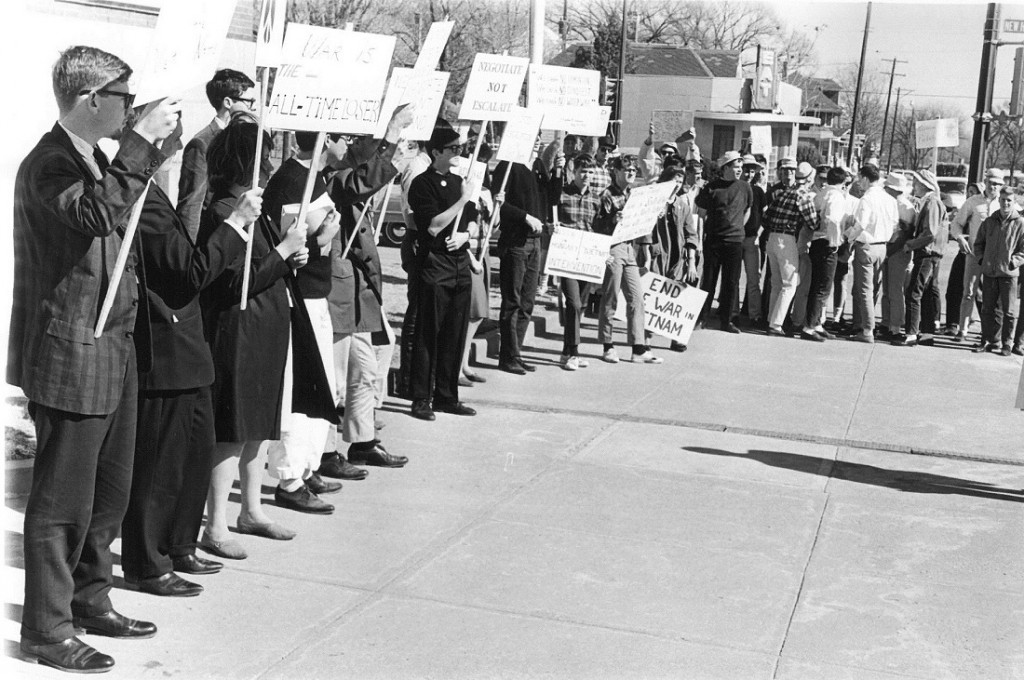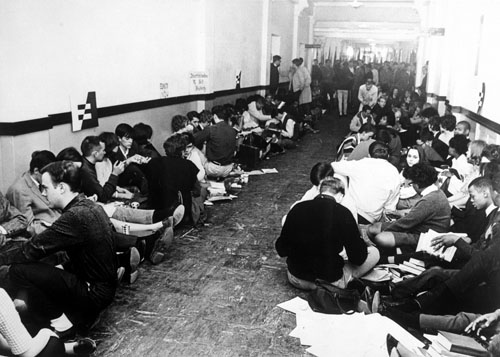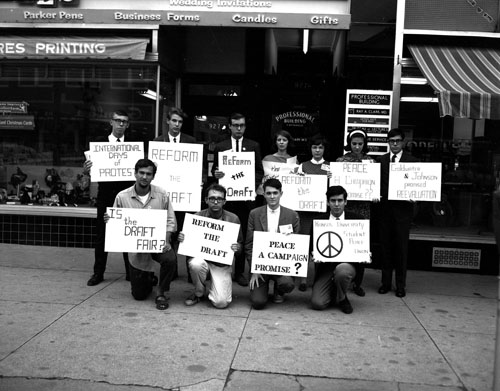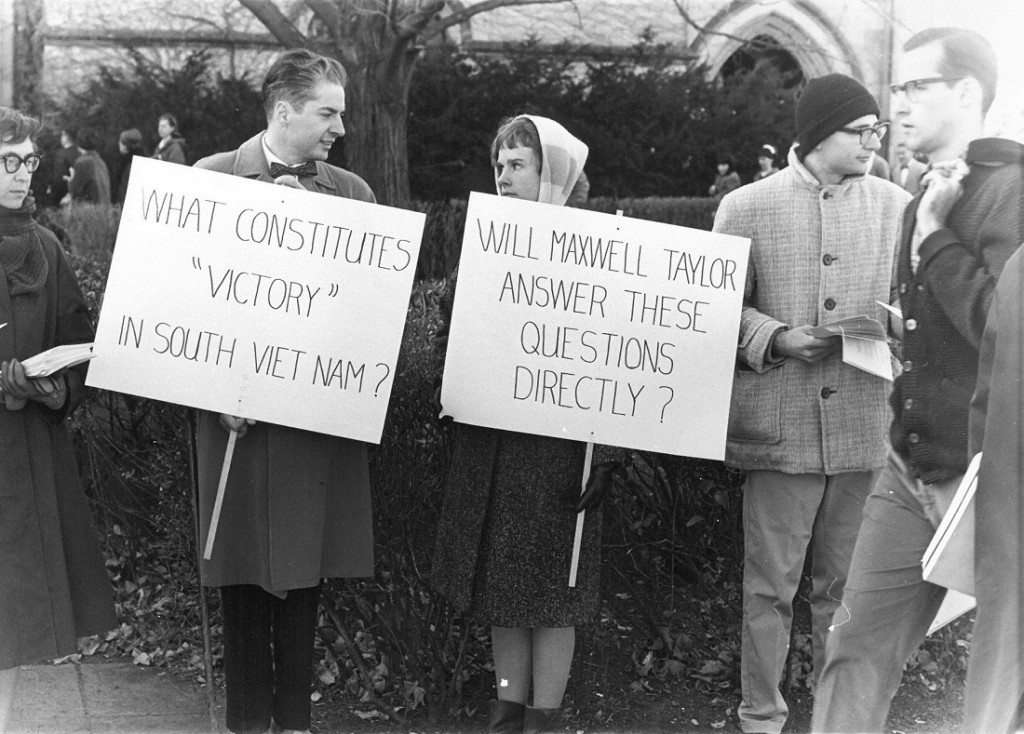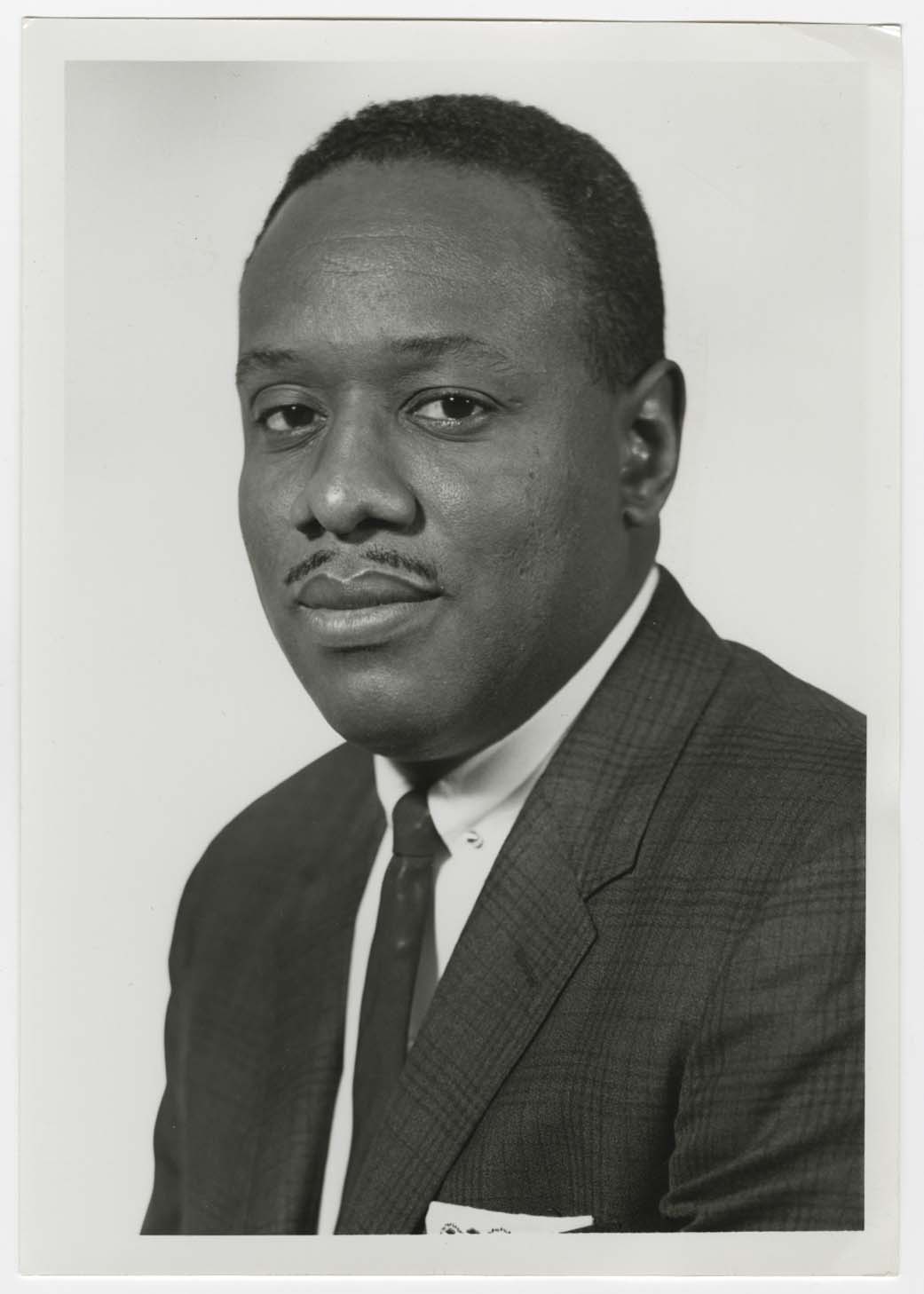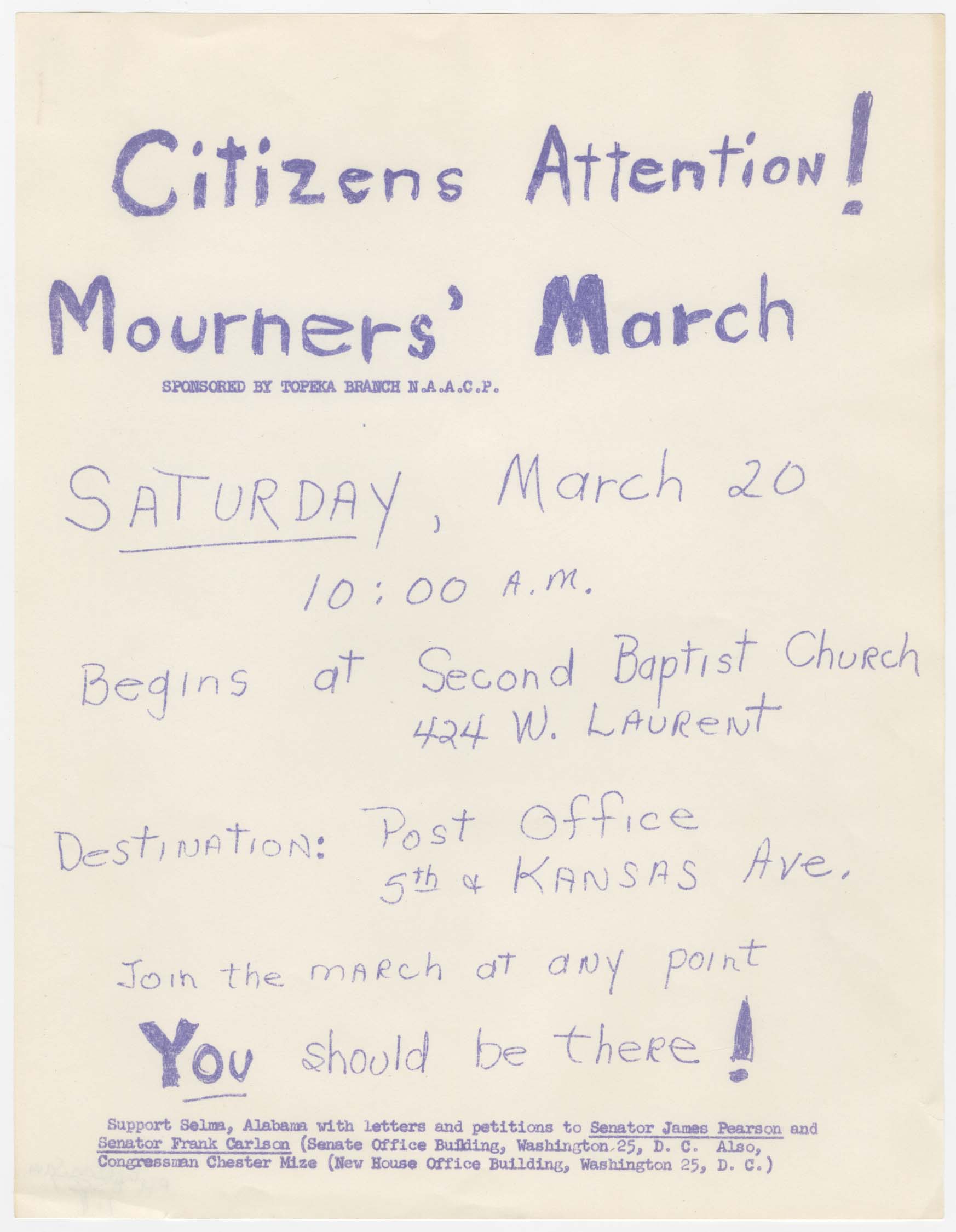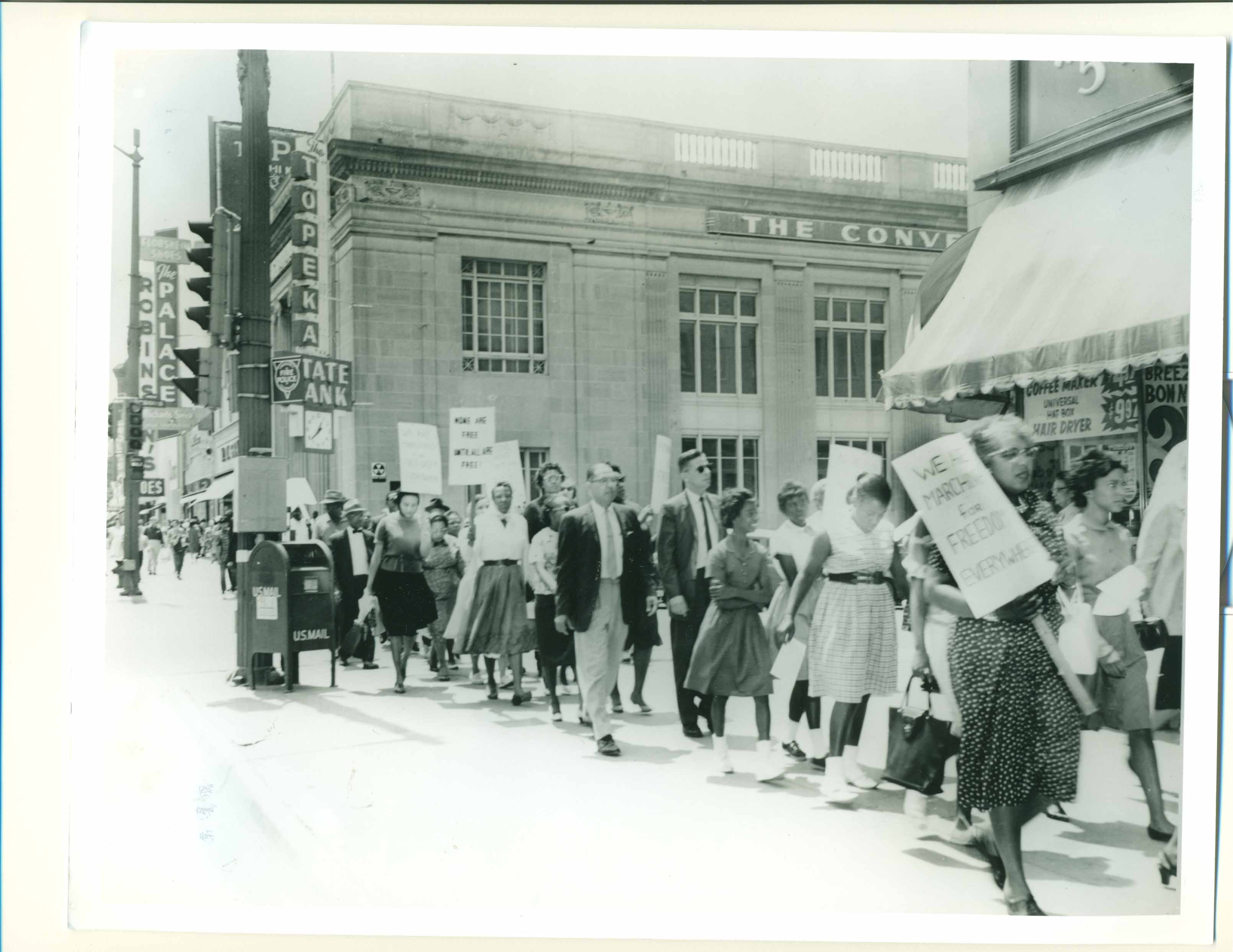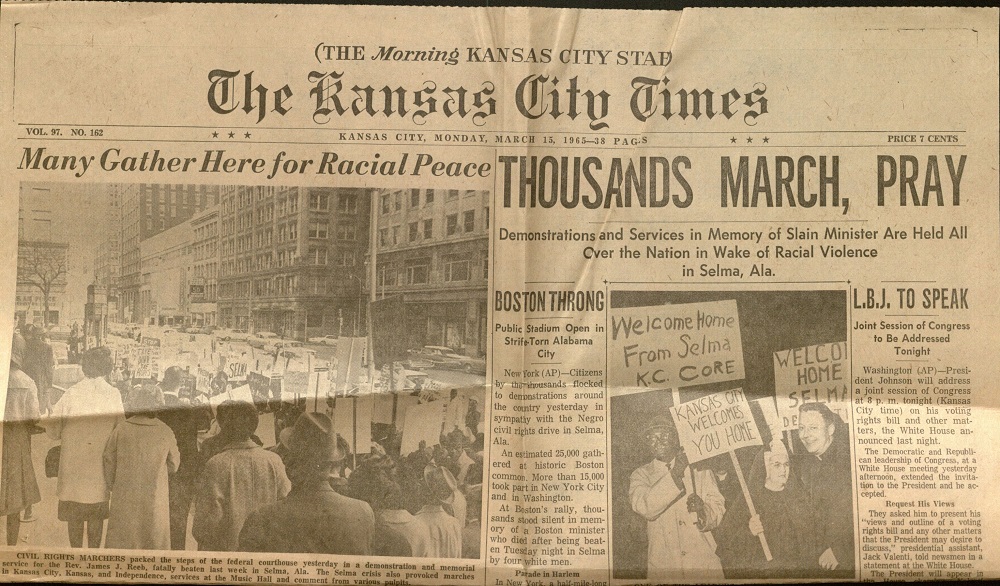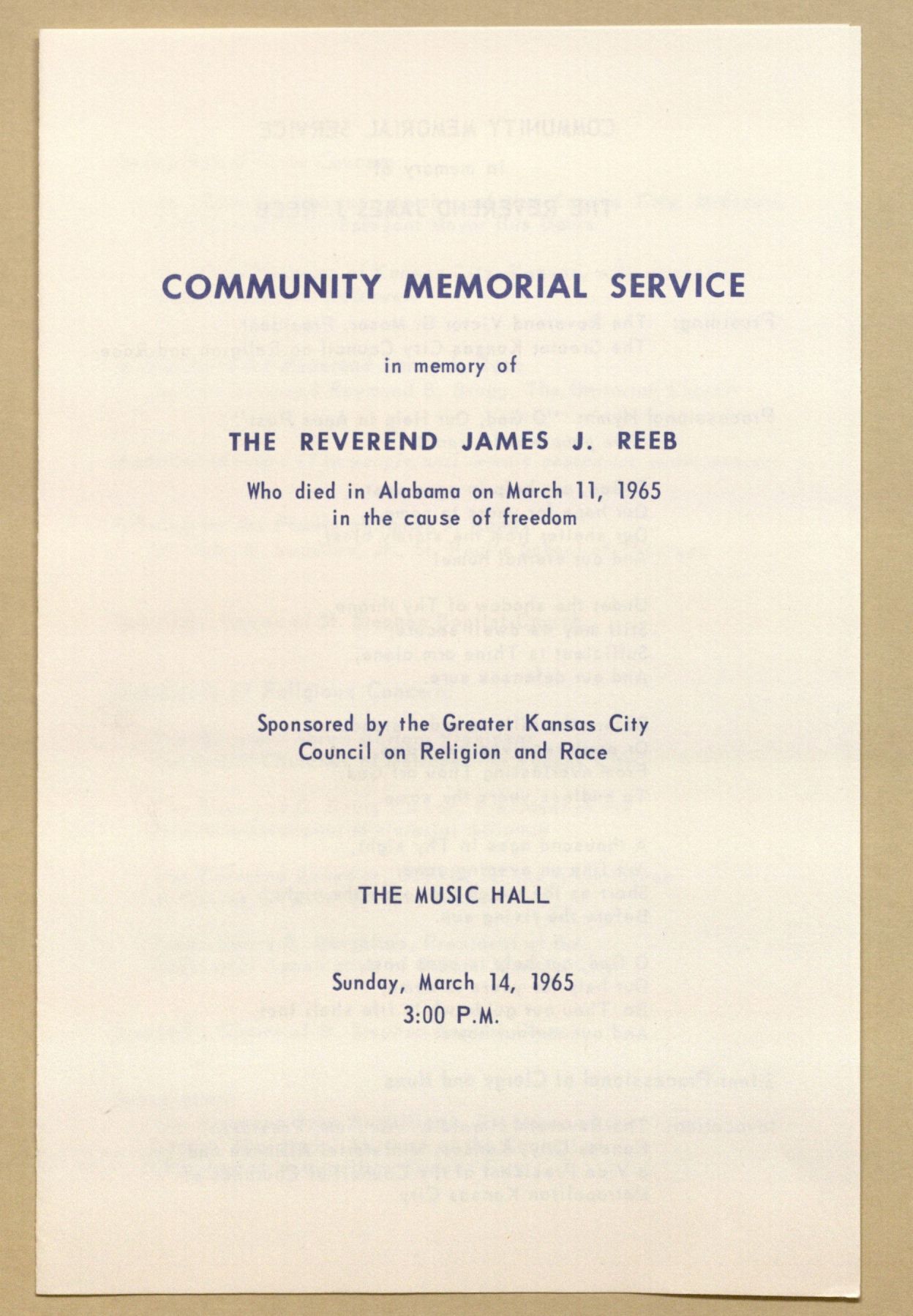“We’re All Going to Jail, to Jail”: The University and Civil Rights in 1965
March 23rd, 2015The 1960s were an iconic time in the United States, marked by social activism and cultural conflict. Lawrence was no exception, and the University of Kansas also experienced civil unrest throughout the decade. This is the first in a two-part series about two very tumultuous years for the university. The year 1965 saw a sit-in at Chancellor Wescoe’s office in Strong Hall. While it was perhaps the most well-known of the protests that year, the demonstration was just one of many to thrust students against authority, inequality, and war. What follows is a timeline of some of the events from that year.
Group of Vietnam protestors in downtown Lawrence, February 21, 1965.
Lawrence Journal-World Photo Collection, University Archives Photos.
Call Number: RG LJW 71/18 1965: Student Activities: Student Protests (Photos).
Click image to enlarge.
February 24: Civil Rights Housing Picket
Approximately thirty-five members of the Civil Rights Council (CRC) staged a picket just before a speech by noted civil libertarian Supreme Court Justice William O. Douglas. Picketers were not against Douglas but were opposed to KU’s complicity in housing discrimination. Douglas spoke to 2,000 in Hoch Auditorium on the role of international law in the nuclear age.
Justice William O. Douglas speaking to the crowd at Hoch Auditorium, February 24,1965.
University Archives Photos. Call Number: RG 0/19 Douglas, William O.:
University General: Visitors (Photos). Click image to enlarge.
March 8-9: Fair Housing Sit-In and March
150 members of CRC, both black and white students, gathered in the corridor outside of Chancellor Wescoe’s office the morning of March 8th. The hope was to bring attention to the administration’s unspoken approval of discrimination in campus housing and approved organizations, like fraternities and sororities. The group came with a list of seven demands that the students wanted Wescoe to approve immediately. They included the abolishment of racially discriminatory practices of sororities and fraternities; a rule that the University Daily Kansan could no longer publish advertisements of racially discriminatory landlords and/or organizations; and the formation of a committee of students, faculty members, and administrators to resolve such grievances on campus.
Protestors came and went throughout the day, but as the doors were to be locked to the Chancellor’s suite, 110 of the participants refused to leave. Those that remained were arrested by Lawrence police and taken to county and city jails where they were charged with disturbing the peace and then released on bond. While Lawrence was not the center of the national civil rights movement, those 110 protestors arrested was the largest number besides a demonstration led by Reverend Martin Luther King, Jr. in Alabama. That night around 400 conducted a peaceful candlelight march near the Chancellor’s residence, singing “We Shall Overcome.”
The following day, the demonstrators returned with signs and stood in front of Strong Hall. Wescoe met with representatives from several groups and ultimately met the protesters’ demands. “The 1965 demonstration was perhaps the most successful civil rights protest ever in Lawrence,” said noted Lawrence historian, Rusty L. Monhollon. It did not fix all of the issues immediately, but it was the start of student equality.
Civil rights sit-in protest in Strong Hall, 1965. University Archives Photos.
Call Number: RG 71/18 1965: Student Activities: Student Protests (Photos).
Click image to enlarge (redirect to Spencer’s digital collections).
March 17: Blood Splashed on ROTC Posters
Charles Hook, president of the University’s Student Peace Union (SPU), slashed his left wrist and spattered his blood on a U.S. Navy bulletin board in the hallway of the Military Science Building on campus. It was a protest against U.S. foreign policy in Vietnam. Hook said the action was “purely spontaneous and an individual gesture” and intended to make the ROTC think about the consequences of their training. United States action in Vietnam would be the cause of several protests on campus and across the country during this time.
March 22-26: Vietnam Vigil at KU
Monday evening began a picket-vigil at the KU Military Science Building. Once again, Charles Hook led the demonstration against U.S. policy in Vietnam and military methods of accomplishing goals. The SPU would have at least one member stand vigil throughout the next several days and nights.
April 28: Park Plaza Fair Housing Picket
Members of the Congress of Racial Equality (CORE), National Association for the Advancement of Colored People (NAACP), and CRC picketed the office of Park Plaza South apartments in Lawrence for not allowing two African American students to rent from them. Led by KU professor Mildred Dickeman, a member of CORE, the picketers stand outside the office from 9 am to 5 pm demanding that the apartment complex implement a non-discriminatory policy.
May 11: Edward Teller H-Bomb Protest
Dr. Edward Teller was a University of California physicist widely regarded as “the father of the hydrogen bomb.” His speech discussed “The Responsibility of the Scientist” and the effects of nuclear war. Dr. Teller’s speech was picketed by twelve representatives of SPU at KU. They stood outside Hoch Auditorium and carried signs that said “Dr. Strange Teller?” and “Bombs for Peace?”
May 21: Third ROTC Review Picket
A group of twenty people representing the SPU picketed the annual ROTC Review in Memorial Stadium. They carried signs reading “The U.S. Talks Peace But Drops Bombs,” “Voluntary ROTC Is a Vote for War,” and “Do We Want Peace in Vietnam or a Piece of Vietnam?” According to Charles Hook, the group hoped to influence some of the cadets to drop out of the ROTC program. Two of the men wore suits and several others wore sports shirts with ties. They marched around the football field during the event. The ROTC Reviews were a popular event to picket and protest during the 1960s and into the 1970s.
Flyer outlining the Student Peace Union’s agenda and itinerary for the ROTC Review, undated.
University Archives. Call Number: RG 67/38 Student Peace Union Records.
Click image to enlarge.
September 22: KU Committee to End War in Vietnam forms
The purpose of the committee was “to provide a nucleus for the channeling of student and faculty opposition to the U.S. policies in Vietnam.” Led by Errol Harris, professor of philosophy, the group planned to focus on educational programs like teach-ins and inviting well-known speakers to campus. One member stated that it is the responsibility of students to inform themselves about a situation for which they may be called upon to give their lives. This attitude would continue at KU for several years as the conflict in Vietnam escalated.
Vietnam protestors with signs in front of a store on Massachusetts Street, October 16, 1965.
University Archives Photos. Call Number: RG 71/18 1965: Student Activities: Student Protests (Photos).
Click image to enlarge (redirect to Spencer’s digital collections).
December 6: General Taylor/Vietnam Demonstration
General Maxwell Taylor, former ambassador to South Vietnam, appeared for a press conference in the Regents Room of Strong Hall and then delivered a forty-five-minute talk in Hoch Auditorium. A capacity crowd of about 4,000 people attend the speech. Two different groups demonstrated in front of Hoch to protest certain aspects of the war in Vietnam. One was a silent vigil sponsored by the KU-Vietnam Committee and the other was a vocal protest sponsored by The United Campus Christ Fellowship.
Protests in advance of Maxwell Taylor’s speech, December 5, 1965.
Lawrence Journal-World Photo Collection, University Archives Photos.
Call Number: RG LJW 71/18 1965: Student Activities: Student Protests (Photos).
Click image to enlarge.
General Maxwell Taylor speaking inside Hoch Auditorium on December 6, 1965.
Lawrence Journal-World Photo Collection, University Archives Photos.
Call Number: RG LJW 0/19 Taylor, Maxwell: University General: Visitors (Photos).
Click image to enlarge.
JoJo Palko
University Archives Intern

